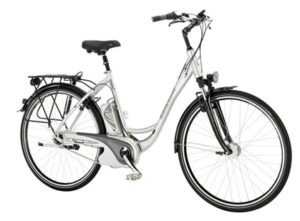Electric Bike Motor – How Much Power Do You Need?
 When looking at electric bikes you may come across information on the watts that an electric bike is rated for. Understanding how many watts you will need for an electric bike can be confusing.
When looking at electric bikes you may come across information on the watts that an electric bike is rated for. Understanding how many watts you will need for an electric bike can be confusing.
The following is guest post by Ed Benjamin about the common sizes of electric motors found on electric bikes and some background on the what will suit your electric bike riding needs the best. Ed Benjamin is the founder of the Light Electric Vehicle Association (LEVA).
What is the Difference in Motor Power 250w, 500w, 750w, By Ed Benjamin
2. How that power is measured. An argument can be made to measure power in these ways:
- A. Electric current into the motor.
- B. Mechanical power output at the “shaft”. (but if it is a hub motor…do we measure at the hub flange or the rim / tire?
- C. Power in, less the efficiency losses of that motor. (Complicated.) And 2A: Whose machine and which method do we use to measure that power? In the EU, there are detailed regulations about how to measure power. In the USA, it is pretty much what the maker says it is, with no testing method described or required.
4. How much power can the battery support? There is a balance of cost, weight, and energy storage in the decisions about the motor power, battery size, etc.
This is not a simple subject. But I will offer my advice:
- Most 250 watt systems are satisfactory for pedelecs (where the rider is pedaling and thus adding in his energy / effort).
- For throttle controlled, or power on demand systems where the rider is not pedaling 350 to 500 watt systems are a better choice.
- 750 watts seems attractive, but this requires a big battery – and the combination of cost and weight is not that attractive. This will get better, but at this time, 500 watts may be a better choice in many cases.
Climbing hills on any of these will require the rider to add in some muscle power – but not a lot.
In all cases, the rider will enjoy the ride, sweat a lot less, and have less fatigue and go farther, faster.
Thanks!
-Pete
P.S. Don’t forget to get sign up for updates from the electric bike world, plus ebike riding and maintenance tips! (upper right hand corner of this site)
Reader Interactions
Comments
Trackbacks
-
[…] Electric Bike Motor – How Much Power Do You Need? […]



This is really interesting, great website guys!
This is a great website, how ironic that there’s more interest in electric bikes rather than cars, when we need the cars now,
Great information. I will print out this article to show to my customers. The systems I sell are 500-750 watt 36v electric bike kits.
There is a huge trade-off between power and weight at the moment. So, another aspect to take into consideration is the weight of the bike. Some low end e-bikes powered by 250 watt motor are substantially weighty, taxing the battery and motor. Most bikes powered by 700+ watts are ridiculously heavy, becoming almost scooter-like. Hopefully new battery and hub tech will bring the weight down, and the wasted energy as well.
Getting back to the article topic, I think 250 can be ample power if the ebike is light enough, but that is certainly not the case with most ebikes on the market.
i wish cycling journalists would stop harping on about the increased weight of an ebike
you don’t get something for nothing and to not be intimidated by hills anymore is well worth the extra weight and dollars
I am planning on adding a top to a bicycle so I can mount a solar cell on top to propel the motor, I will be using two good size batteries, with the solar cell to propel the bike. I would like to have the bike run a very long distance without needing a charge. What size motor would you recommend for such a project. Thank you. Michael.
Hi Michael,
You may want to contact Terry at the SolarCross EV project about that. He has been doing some interesting work with a solar powered e-bike.
https://www.solar-cross.thekpv.com
Hope that helps.
the extra weight of the motor and battery of an ebike + rider is inconsequential,
an ‘average’ pedal bike is around 25# an ‘average’ ebike is 50#
OMG that’s 100% more!! but
bikes don’t ride themselves so you have to talk about
the percent difference in weight of the two bike/rider systems
pedal bike/rider system is 25# + 180# = 205#
ebike/rider system is 50# + 180# = 230#
the percent increase is only 12% and
that doesn’t mean the overall ebike performance will be 12% less.
many of us are carrying around +20# extra anyway!
it’s an e-assisted bike people!!
the e-assist far more than compensates for the +12% ‘extra’ weight,
the extra weight of the ebike is only a problem
if you have to lift and/or carry it and
almost half the extra 25# can be removed by removing the battery
Looking information on building a delta recumbent trike that could be made electric to work for me because of my handicap. Only one arm, over 70.